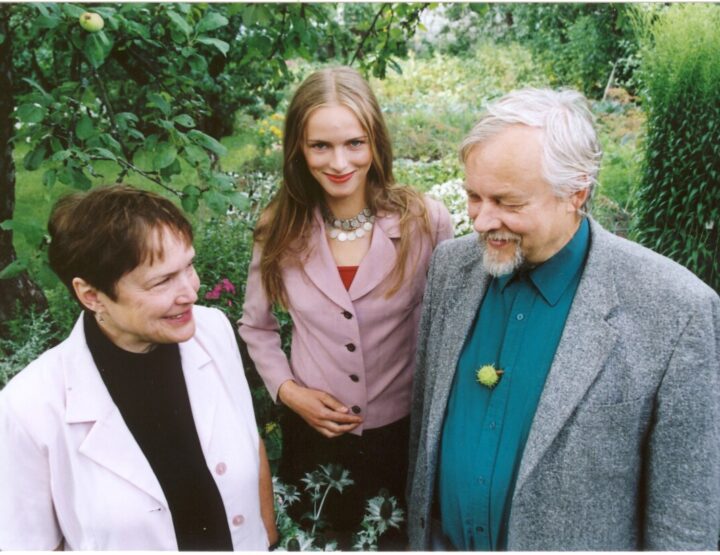Jüri Ehlvest is one of the most original Estonian prose authors of the 1990s, and also most difficult to interpret. The critics have been intwo minds, calling Ehlvest’s work either medium-level absurd prose or a starting point of a new era of prose. Ehlvest’s short stories began appearing as early as the second half of the 1980s; his first book was published in 1996.
Jüri Ehlvest was born in 1967 in Tallinn, went to school there, and has been living in Tartu since 1985. He read biology at the University of Tartu for two years, then abandoned his studies and is now a freelance bohemian writer in Tartu. The turn of the decade saw him busily participating in the activities of a new and radical literary generation. Together with Sven Kivisildnik they formed an obscure-absurd literary society called Abi-Piirissaare Dalinistlik Kõõl; a bit later Ehlvest belonged to the group Hirohall, being the only prose writer. The group was closely associated with the Estonian Kostabi Society, which was one of the first strong alternative literary institutions besides the Writers’ Union and large publishing houses. Quite soon, Ehlvest became famous for his highly original world of his short stories with a dense intertextual texture, mostly published in the magazine Vikerkaar.
In 1996, Jüri Ehlvest published two books – the novel Ikka veel Bagdadis (Still in Baghdad, publisher EÜS Veljesto), and a collection of short stories Krutsiaania (publishing house Tuum). The latter immediately attracted attention, receiving the annual short story award; the title story got the Tuglas short story award. In 1997, a selection of stories came out, titled Päkapikk kirjutab (The Gnome Writes); in 1988 a collection of short stories, Elumask (The Mask of Life), and in 1999 a short novel Elli lend (Elli’s Flight) were published. In recent years Ehlvest has tried his hand in drama (having attended some drama courses himself). Together with Margus Kasterpalu and Ilmar Raag he wrote the text for the open air production, Viimne võttepäev (The Last Day of Shooting); his short plays have been staged by the drama students.
Ehlvest’s work can be divided into two, with the division line in the middle of the last decade. His earlier work, best represented by the collection Gnome, also about half the Krutsiaania stories, is somewhat more traditional (whether it is at all possible to talk about traditions in Ehlvest’s case). These stories have some sort of composition, the centre of which reveals the opening of an enigmatic phenomenon – recollections hidden in the depths of memory, a mysterious text or an unsolvable human relationship. At the same time the stories have a hermetic flavour to them if to read them according to the rules of the usual mimetic literature. As for its narrative structure, Ehlvest’s later work is even more vague; the meta-literary attitude increases, the focus is often directed at the narration of the stories themselves.
Searching for a general typical feature of Ehlvest’s prose, mention should perhaps be made of a continuous intertwining of different levels, and simultaneously a withdrawal into himself. By intertwining I primarily mean a very active intertextuality. The latter is not so much conscious as subconsciously dreamlike, and this is both the writing principle of the stories themselves, and an important activator of the plot. There are times when a text or a textual tradition seems to become the main character of a story. Besides the usual literary allusions Ehlvest’s stories abound in all sorts of metaphysical or mystical constructions, from theology, philosophy, occult sciences, mathematics, intellectual games, etc. (It should be mentioned that he also briefly studied theology and participated in analytical philosophy seminars and that his brother Jaan Ehlvest is a world-class chess player.)
The second aspect of intertwining is the fact that all the intertextual allusions both on the level of narration and action are not clearly defined, but are overlapping and blending into the plot itself. It can easily happen that a character in an alluded text steps into the main line of activity, or the activity transforms into a text read by the characters of the story. Despite their many layers and voices, Ehlvest’s stories are not polyphonic or symphonic, they rather resemble a radio concert, with constant interruptions from other stations, whereas these different stations seem to actually hear one another and occasionally adjust their programmes to the others. The reader frequently bumps into a certain shift of perception – a perspective is created, only to be shattered immediately; what seemed far away, is suddenly nearby, concealing things that stand closer. The transition may occur either via hidden structural similarities of different levels, or via the similarity of sound of a single word. An unprepared reader may think these stories as haunting descriptions of paranoia where the real and the imaginary blend into a frustrating confusion which nevertheless has its own inevitable logic. (This can, however, have an unpleasant effect even on the prepared reader. The undersigned, having read all Ehlvest’s books during the period of a few days, and on top of that watched David Cronenberg’s existential science fiction film ‘eXistenZ’ where the borders between the virtual and the real vanish, had his sleep greatly disturbed, rather like the narrative ‘disturbances’ in Ehlvest’s stories.)
The other typical feature is retreating or closing into oneself. Ehlvest’s stories often do not constitute a solution of the initial situation, but instead they wrap themselves into the situation by way of solving it. This first impression may easily be false, because the only thing that one can get wrapped in in Ehlvest’s stories is the telling itself that creates the stories, so that also the characters seem to be just as bewildered as the readers. The critic Kajar Pruul has interpreted Ehlvest’s novel Still in Baghdad as a postmodern parallel to The Thousand and One Nights where the point of telling the stories means postponing something terrible and inevitable. The same motif, after all, is expressed by Michel Foucault in his essay Language to infinity – to talk in order to postpone death. The end of the story means death to the narrator – and what’s more important in the context of Ehlvest – the end of the narration means the death of the story itself, its congealing, and this in turn would mean getting trapped inside the story. So when the narrating seems to retreat into itself, it in fact keeps itself open. The frequent mixing of levels in Ehlvest’s stories follows the same principle – levels must not be kept as separate entities, or they may expire.
Jaanus Adamson (who has read a special course on Ehlvest’s work at the Estonian Institute of Humanities) has described the novel Elli’s Flight as follows. The novel has three levels – a love story about Elli and Aulis, a meta-novel about the problems of writing this novel, and an essay-novel that consists of the characters’ ideas on various topics. All three levels have been thoroughly mixed until they can no longer be differentiated. Using the motif of a delicious dish made from an uncongealed egg, taken from the novel itself, Adamson says: “It has to be drunk very quickly so the text wouldn’t ‘congeal’, it actually must scorch us a bit.” This rather well conveys the right method of reading Ehlvest – his texts with its thorough developments of motifs and passages resembling serious philosophy apparently demand concentration, but that in fact is deceptive. Instead, one should focus on other levels of text (In Elli’s Flight the main character, i.e. narrator, expresses an idle idea: “It is possible to be deep also superficially.”)
Ehlvest’s peculiarity mostly lies in his playing about with the reading habits of the short story genre (novels are no exception here, because Still in Baghdad is actually a collection of short story excerpts joined into a frame-story, and Elli’s Flight a short story stretched into a novel). The ‘ideology’ of the novel is connected with clear narrative schemes, a short story is the best way to express them. A clear intrigue, development, culmination, etc. must be present here. In a short story, compared to a novel, all this goes on almost in a ‘naked’ form. The craft of a short story lies in whether a story is told skilfully, i.e. whether the familiar mechanisms of telling a story can fascinate us enough, without attracting attention to themselves. Ehlvest is not trying to achieve that. On the other hand it would be far too simplistic to see ‘meta-short stories’ in Ehlvest’s stories that would ‘uncover’ the narrating. Faced with a choice – either to tell a story or tell a story about telling the story, Ehlvest finds a third path. There he uses the technique of creating a meaningfulness that differs from the usual logic of the narrative. It could be said that Ehlvest uses a technique much more typical of poetry; narrative elements are associated by ways normally used in constructing poems. The logic of Ehlvest’s short stories requires a perception of the reader according to which the phenomena of different levels are associated more freely. Like in a poem, where the most meaningful element can be the phonetic composition of words or the rhythm or a metaphorical identification of the incompatible phenomena, so the most significant thing in Ehlvest’s stories can easily be a structural parallelism of levels, or a harmony of separate elements on a rather optional basis, which is nevertheless quite motivated as for these very elements. The normal reading models survive as well, being in a dialogue with these innovations and making the whole reading more tense. Ehlvest’s short stories, like poems, cannot be adequately retold.
In conclusion, we might hear a brief comment of Jüri Ehlvest himself. In the collection of articles in 1997, Estonian Writers Union 75, the writers are asked: “How do you see a writer’s role in our present day, in the Republic of Estonia?” Ehlvest replies: “The writer frees people from the bonds that have been made of the orders demanding truth. The writer adds realities that do not constitute hidden mental traps.” This may even sound somewhat trite, an extract from a Foucaultesque postmodernist anti-ideology discourse; but this idea of Ehlvest’s should certainly be taken seriously, because it relies on the texts that consist of liberating the flow of meanings via simulations of truth. Or, according to an Ehlvestian logic: the short story is not dead, long live the short story.
A brief overview of Jüri Ehlvest
By Aare Pilv
–
Share:



